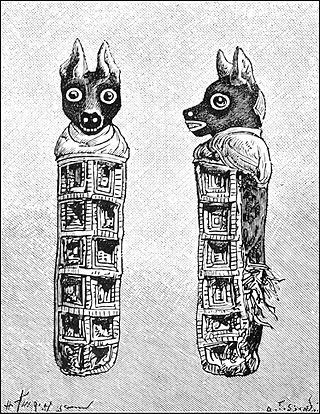
Zooarchaeology merges the disciplines of zoology and archaeology, focusing on the analysis of animal remains within archaeological sites. This field, managed by specialists known as zooarchaeologists or faunal analysts, examines remnants such as bones, shells, hair, chitin, scales, hides, and proteins, such as DNA, to derive insights into historical human-animal interactions and environmental conditions. While bones and shells tend to be relatively more preserved in archaeological contexts, the survival of faunal remains is generally infrequent. The degradation or fragmentation of faunal remains presents challenges in the accurate analysis and interpretation of data.

Ascaris lumbricoides is a large parasitic worm that causes ascariasis in humans. A roundworm of genus Ascaris, it is the most common parasitic worm in humans. An estimated 807 million–1.2 billion people are infected with A. lumbricoides worldwide. People living in tropical and subtropical countries are at greater risk of infection.
Archaeogenetics is the study of ancient DNA using various molecular genetic methods and DNA resources. This form of genetic analysis can be applied to human, animal, and plant specimens. Ancient DNA can be extracted from various fossilized specimens including bones, eggshells, and artificially preserved tissues in human and animal specimens. In plants, ancient DNA can be extracted from seeds and tissue. Archaeogenetics provides us with genetic evidence of ancient population group migrations, domestication events, and plant and animal evolution. The ancient DNA cross referenced with the DNA of relative modern genetic populations allows researchers to run comparison studies that provide a more complete analysis when ancient DNA is compromised.

A coprolite is fossilized feces. Coprolites are classified as trace fossils as opposed to body fossils, as they give evidence for the animal's behaviour rather than morphology. The name is derived from the Greek words κόπρος and λίθος. They were first described by William Buckland in 1829. Before this, they were known as "fossil fir cones" and "bezoar stones". They serve a valuable purpose in paleontology because they provide direct evidence of the predation and diet of extinct organisms. Coprolites may range in size from a few millimetres to over 60 centimetres.
Steatorrhea is the presence of excess fat in feces. Stools may be bulky and difficult to flush, have a pale and oily appearance, and can be especially foul-smelling. An oily anal leakage or some level of fecal incontinence may occur. There is increased fat excretion, which can be measured by determining the fecal fat level. The definition of how much fecal fat constitutes steatorrhea has not been standardized.

Cryptosporidium parvum is one of several species that cause cryptosporidiosis, a parasitic disease of the mammalian intestinal tract.

Paleopathology, also spelled palaeopathology, is the study of ancient diseases and injuries in organisms through the examination of fossils, mummified tissue, skeletal remains, and analysis of coprolites. Specific sources in the study of ancient human diseases may include early documents, illustrations from early books, painting and sculpture from the past. All these objects provide information on the evolution of diseases as well as how past civilizations treated conditions. Studies have historically focused on humans, although there is no evidence that humans are more prone to pathologies than any other animal.

Parasitic worms, also known as helminths, are large macroparasites; adults can generally be seen with the naked eye. Many are intestinal worms that are soil-transmitted and infect the gastrointestinal tract. Other parasitic worms such as schistosomes reside in blood vessels.

Ancient DNA (aDNA) is DNA isolated from ancient specimens. Due to degradation processes ancient DNA is more degraded in comparison with contemporary genetic material. Even under the best preservation conditions, there is an upper boundary of 0.4–1.5 million years for a sample to contain sufficient DNA for sequencing technologies. The oldest sample ever sequenced is estimated to be 1.65 million years old. Genetic material has been recovered from paleo/archaeological and historical skeletal material, mummified tissues, archival collections of non-frozen medical specimens, preserved plant remains, ice and from permafrost cores, marine and lake sediments and excavation dirt. In 2022, two-million year old genetic material was found in Greenland, and is currently considered the oldest DNA discovered so far.

5β-Coprostanol (5β-cholestan-3β-ol) is a 27-carbon stanol formed from the net reductive metabolism of cholesterol (cholest-5en-3β-ol) in the gut of most higher animals and birds. This compound has frequently been used as a biomarker for the presence of human faecal matter in the environment. 5β-coprostanol is thought to be exclusively bacterial in origin.
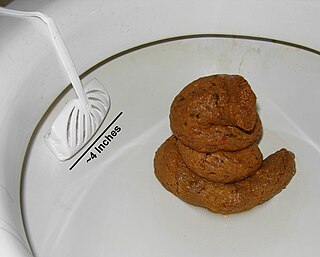
Human feces are the solid or semisolid remains of food that could not be digested or absorbed in the small intestine of humans, but has been further broken down by bacteria in the large intestine. It also contains bacteria and a relatively small amount of metabolic waste products such as bacterially altered bilirubin, and the dead epithelial cells from the lining of the gut. It is discharged through the anus during a process called defecation.

The Paisley Caves or the Paisley Five Mile Point Caves complex is a system of eight caves in an arid, desolate region of south-central Oregon, United States north of the present-day city of Paisley, Oregon. The caves are located in the Summer Lake basin at 4,520 feet (1,380 m) elevation and face west, carved into a ridge of Miocene and Pliocene era basalts mixed with soft volcanic tuffs and breccias by Pleistocene-era waves from Summer Lake. One of the caves may contain archaeological evidence of the oldest definitively-dated human presence in North America. The site was first studied by Luther Cressman in the 1930s.

Archaeoparasitology, a multi-disciplinary field within paleopathology, is the study of parasites in archaeological contexts. It includes studies of the protozoan and metazoan parasites of humans in the past, as well as parasites which may have affected past human societies, such as those infesting domesticated animals.

Paleoparasitology is the study of parasites from the past, and their interactions with hosts and vectors; it is a subfield of paleontology, the study of living organisms from the past. Some authors define this term more narrowly, as "Paleoparasitology is the study of parasites in archaeological material." K.J. Reinhard suggests that the term "archaeoparasitology" be applied to "... all parasitological remains excavated from archaeological contexts ... derived from human activity" and that "the term 'paleoparasitology' be applied to studies of nonhuman, paleontological material." This article follows Reinhard's suggestion and discusses the protozoan and animal parasites of non-human animals and plants from the past, while those from humans and our hominid ancestors are covered in archaeoparasitology.

Cestoda is a class of parasitic worms in the flatworm phylum (Platyhelminthes). Most of the species—and the best-known—are those in the subclass Eucestoda; they are ribbon-like worms as adults, known as tapeworms. Their bodies consist of many similar units known as proglottids—essentially packages of eggs which are regularly shed into the environment to infect other organisms. Species of the other subclass, Cestodaria, are mainly fish infecting parasites.
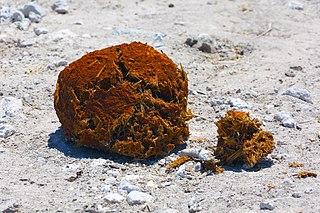
Feces are the solid or semi-solid remains of food that was not digested in the small intestine, and has been broken down by bacteria in the large intestine. Feces contain a relatively small amount of metabolic waste products such as bacterially altered bilirubin, and dead epithelial cells from the lining of the gut.
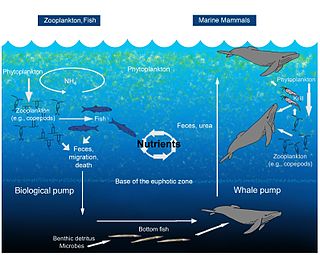
Whale feces, the excrement of whales, has a vital role in the ecology of oceans, earning whales the title of "marine ecosystem engineers." This significant ecological role stems from the nutrients and compounds found in whale feces, which have far-reaching effects on marine life.
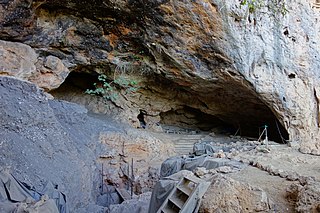
Taforalt, or Grotte des Pigeons, is a cave in the province of Berkane, Aït Iznasen region, Morocco, possibly the oldest cemetery in North Africa. It contained at least 34 Iberomaurusian adolescent and adult human skeletons, as well as younger ones, from the Upper Palaeolithic between 15,100 and 14,000 calendar years ago. There is archaeological evidence for Iberomaurusian occupation at the site between 23,200 and 12,600 calendar years ago, as well as evidence for Aterian occupation as old as 85,000 years.
Lisa-Marie Shillito is a British archaeologist and senior lecturer in landscape archaeology as well as director of the Wolfson Archaeology Laboratory and Earthslides at Newcastle University. Her practical work focuses on using soil micromorphology, phytolith analysis and geochemistry in order to understand human behaviour and landscape change. Her work includes the Neolithic settlements of Çatalhöyük in Turkey and Ness of Brodgar and Durrington Walls in Britain, but also Crusader castles and medieval settlements in Poland and the Baltic and in the Near East.
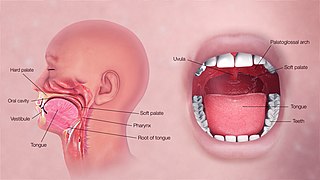
The evolution of the human oral microbiome is the study of microorganisms in the oral cavity and how they have adapted over time. There are recent advancements in ancient dental research that have given insight to the evolution of the human oral microbiome. Using these techniques it is now known what metabolite classes have been preserved and the difference in genetic diversity that exists from ancient to modern microbiota. The relationship between oral microbiota and its human host has changed and this transition can directly be linked to common diseases in human evolutionary past. Evolutionary medicine provides a framework for reevaluating oral health and disease and biological anthropology provides the context to identify the ancestral human microbiome. These disciplines together give insights into the oral microbiome and can potentially help contribute to restoring and maintaining oral health in the future.

















